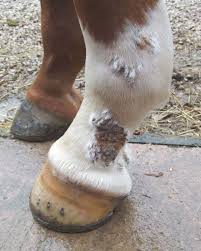Mud fever (also known as pastern dermatitis) is a common condition of the lower limbs, especially the back legs, where the skin becomes inflamed and scabby with oozing serum; the coronet, pastern and heels of the foot may also become cracked; in severe cases the leg may swell and the horse may develop lameness. Mud fever is also referred to as cracked heels or greasy heel. Horses with particularly hairy feathers, white legs or pink skin are more prone to mud fever. The condition can also affect the upper body and is usually referred to a rain scald or rain rot.
The idea that mud fever is always caused by a single bacterium called Dermatophilus congolensis is no longer true. Although one species is often the dominant cause, most cases are caused by complex mixtures of several different bacterial species, there may also be fungus organisms present. It is sometimes possible to make an educated guess at which species are present by the nature of the damage. Staphylococcal bacteria usually cause considerable inflammation and pain, and so handling and washing are strongly resented. The milder Dermatophilus bacteria cause less exudate and less pain. There is also less scabbing associated with it than either Staphylococci or Streptococci. Fungal infections, and some other bacteria, cause a much “smellier” exudative dermatitis.
Remarkably, the infectious causes, and some of the rare non-infectious diseases associated with pastern dermatitis, affect the white skinned legs much more than the darker ones. There have been suggestions that exposure to sunlight is an issue, but it seems that there is much more to it than that. There is no obvious detectable reason for this when the skin is examined under the microscope.
In all cases then there will be some degree of pain, skin damage and exudate. There may also be matted hair over the surface of an ulcerated skin surface. Some horses become significantly lame and others may develop filling in the affected limb.
The possible/probable cause of any case may be easy to identify, eg many cases need persistent wetting and some sort of damage to the outer layers of the skin. These cases are the ones that most often occur in winter during very wet periods, hence the name Mud Fever.
The varied causes of infectious pastern dermatitis are often contagious and can spread between horses if the conditions allow. Heavily infected cases may act as a source of infection for many others, and may carry the organisms involved during periods of lesser severity. Diagnosis is usually made after a careful clinical examination and collection of specimens from the skin and exudate.
Unfortunately the diagnosis of pastern dermatitis is also complicated by several other possible conditions that look very similar. Most of these are much less common, but that is no consolation if it is your horse. That is why it is very important to try to establish a proper and full diagnosis, only then can treatment be given that will specifically control the disease. Some of the more rare forms are in fact very difficult to treat, and one of the major problems with these cases is that the pastern dermatitis may be part of a much wider systemic disease that affects skin or even internal organs, eg pastern dermatitis affecting only the white limbs may be due to photosensitization due to advanced ragwort poisoning. Other cases are related to ingestion of some of the photodynamic plants such as St John’s Wort or Red Clover, and these are much easier to deal with of course.
Diagnosis is usually made after a careful examination and collection of specimens from the skin and exudate. Sometimes this is easy and sometimes it’s very difficult. The pastern is not always a good place to sample! The picture above shows a horse suffering from mud fever in the pastern region. You can see where the mud fever has caused hair loss and exudation which has caused the hair to have a greasy appearance.
How can I treat my horse for mud fever?
Treatment of pastern dermatitis must set out to achieve two main objectives:
- To remove the cause.
- To treat the skin damage
Antibiotics may be needed if it is infectious (call your vet) but a common mistake is to carry out repeated heavy washing of the skin. One of the best principles that can be applied is to render the skin inhospitable to the causative bacteria, this may mean close clipping (even if it’s a feathered horse) and single careful wash with a suitably prescribed antiseptic solution( Again call your vet). It is very important in all these cases to use warm water when washing and rinsing. The worst thing that one can do is to macerate the skin still further by leaving it wet. Blotting dry (rather than rubbing with a towel), and then maintaining dry skin are most important.
By following these important stages you can ensure a successful outcome:
While being treated for mud fever your horse should be stabled to prevent him from coming into further contact with the wet or mud. Make sure the bedding in the stable is dry, clean and non-irritant.
One school of thought is that all the hair around the affected area should be clipped away. Be careful not to break the skin when clipping the affected area otherwise further bacteria will penetrate the skin and cause further infection. However, doing this successfully is very difficult and often the problem is made worse. We have found that that thoroughly cleaning with an antiseptic shampoo or de-greasing hand cleanser, will soften any scabs which need to be removed. If the scabs do not come away easily do not force the issue; removing the scabs a little at a time will cause less trauma to the underlying skin. Instead, repeat the washing/drying and cream application every few days.
The legs should then be thoroughly dried.
The infected skin should be treated with a cream/solution formulated to attack the bacteria that cause mud fever. In severe cases antibiotic treatment may be needed. In this case, you should call your vet.
Once the mud fever has been treated and the bacteria has been destroyed, the affected area must continue to be protected while new skin and hair grows. This process may take a while and the skin may remain tender during this period. It is advisable to apply a soothing cream, eg zinc or castor oil to ease this.



